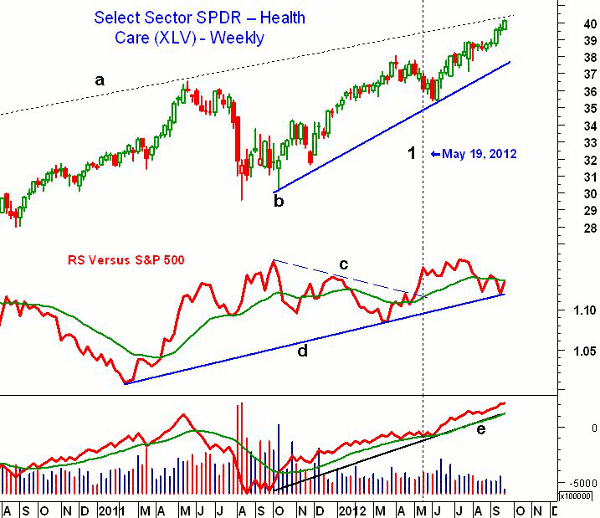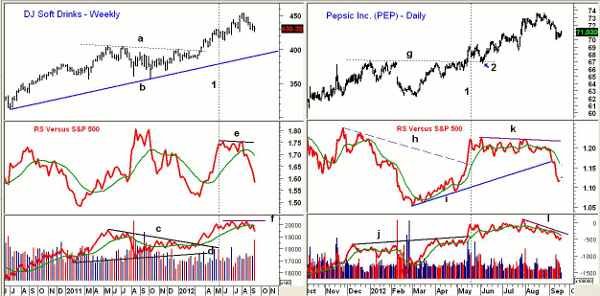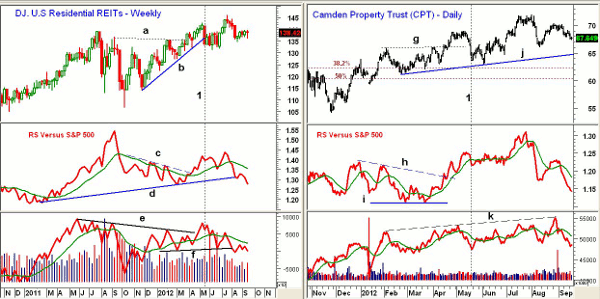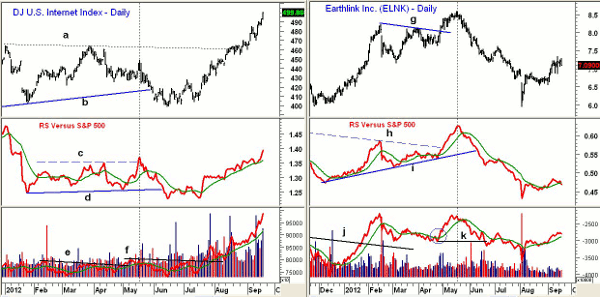A look at four sectors that led the market in the spring shows us not only which industry groups have long-term staying power, but also which technical signals were caught and which points of analysis can be refined for the future, writes MoneyShow's Tom Aspray.
On May 17, with the Spyder Trust (SPY) sitting at $130.86, I wrote a Trading Lesson titled “4 Industry Groups Beating the S&P 500."
The goal of the original article was to provide further examples of how I use relative performance and volume analysis to identify leading industry groups. The same analysis is then used to generate a buy list of stocks in these groups
In terms of the market, in May my view was that “I would expect to eventually see a wave of panic selling before the market can bottom out. This should take each of these stocks back to more important support levels and create good buying opportunities.”
Now that the market has risen sharply from the early June lows, I wanted to review this analysis and provide my readers with an update to judge how the methods work. It will also reveal how the analysis has changed over time.
The first sector I looked at was the Select Sector SPDR Health Care (XLV), as it was holding up much better as the market corrected. On each chart, I have noted the date of the original article by a vertical dashed line (line 1).
The price of XLV had just dropped back to the May 2011 highs, and then over the next three weeks XLV dropped from $36.04 to a low of $35.38, a decline of 1.7%. The correction held well above the 38.2% support from the August 2011 lows of $34.82.
How does XLV look now? It is now approaching the trend line resistance (line a) that connects the late 2009 and early 2011 highs. It has soared 13.2% from the June lows.
The weekly RS analysis had moved above its downtrend (line c) in early May and completed its correction. The RS line did make new highs in July before dropping back below its WMA. It is now testing its uptrend (line d), and I believe that it now warrants closer monitoring.
The weekly on-balance volume (OBV) was trading in a tight range in May, then resumed its uptrend in June. The OBV has confirmed the new highs and is well above its uptrend (line e) and WMA. Though XLV is reaching its resistance, the weekly analysis is definitely positive.
NEXT: A Look at Biotech
|pagebreak|
Two plays in the health-care sector that I mentioned in May were the iShares Nasdaq Biotechnology Index Fund (IBB) and Amgen (AMGN), which are both still in the Charts in Play Portfolio.
In May, I noted that IBB had made new all-time highs and had good support in the $116.40 area. The relative performance had just overcome resistance (line b) and had started a new uptrend. The daily OBV was back below its WMA after a recent rally, and although I did not show it at the time, the weekly OBV was well above its rising WMA.
At the time, I wrote: “For the iShares Nasdaq Biotechnology Index Fund (IBB), go 50% long at $120.14 and 50% long at $117.64, with a stop at $114.82 (risk of approx. 3.4%).”
It is often better to be lucky than good. The day after the article was released, IBB plunged from an open of $122.17 to a low of $114.97, but then closed at $120.40, as most of the stops had been cleaned out and the buyers had stepped up.
There was not a lot of magic in my stop determination. I simply wanted to give the market plenty of room under the $116.40 low, as IBB is volatile. Secondly, I wanted to be enough under $115 to protect the position, since round numbers are often just slightly exceeded.
In the latter part of June, IBB rallied to new highs, peaking in July at $138.75 . This was confirmed by the daily technical studies. The sharp setback held the support in the $130 area as IBB once again turned higher.
The rally from the early August lows has taken IBB to a high this week of $144.70. Technically, both the daily and weekly relative performance analysis have not confirmed the recent highs, but the weekly RS line is still well above its WMA.
The daily OBV made new highs last Friday, as volume was heavy again this week. The weekly OBV is acting even stronger.
IBB Position Update: We are still 50% long IBB from an average price of $119. I recommended selling half at $135.44, which was filled on August 24.
With IBB at new highs, the recommended stop on the remaining position is quite wide at $134.54, but I will tighten it if the volume analysis deteriorates.
Moving onto Amgen (AMGN), in May I used a weekly chart and noted that it had closed above the weekly resistance (line g) at the end of April. This completed the continuation pattern, which is why they are one of my favorite chart formations.
A retest of the breakout level would take AMGN back to the $67.50 to $69.50 area. The longer-term uptrend was at $65.70, with the April 16 low at $65.37.
The weekly relative performance had moved back above its WMA, which I noted was a strong sign. The weekly OBV was holding above its WMA after breaking out in December.
The recommendation was: “For Amgen (AMGN), go 50% long at $68.54 and 50% long at $67.12, with a stop at $64.76 (risk of approx. 4.5%).” AMGN only traded as low as $67.61 on June 1, and the weekly close at $71.29 in the middle of June confirmed that the correction was over.
AMGN made a high of $85.27 in late August, and then retested but did not overcome these highs in September. The close last week was below the prior six-week lows, but AMGN is trying to stabilize this week.
The weekly relative performance formed a negative divergence (line i) and dropped below its WMA last week. Though the longer-term RS pattern is positive, this divergence is a sign of weakness.
The weekly OBV has not formed any divergences and is still above its WMA, but the daily OBV does look more negative.
Position Update: Investors were long 50% Amgen (AMGN) from $68.54. We sold half at $76.88, as my first target from May was $77. I currently have the stop set at $79.76. On a move above $82.80, raise the stop to $81.44, and sell the remaining position at $84.33 or better.
NEXT: Coke or Pepsi?
Next, I took a look at the DJ Soft Drinks Group. The weekly chart revealed a major upside breakout through resistance (line a) at the end of March. The yearlong flag formation had upside targets in the 450-460 area.
The group's relative performance was rising sharply, and was well above its rising WMA. The weekly OBV had broken through its resistance (line c) two weeks ahead of prices, then confirmed the highs in early May, and was well above its rising WMA.
The DJ Soft Drinks group hit a high of 453.87 in early August, but has been declining for the past six weeks. Is it now trying to hold above the support in the 425 area.
The relative performance failed to make new highs in early August (line e), and then dropped sharply below its WMA. It is now clearly in a downtrend, as is the daily RS analysis.
The weekly OBV also did not make new highs in August (line f). After a retest of its flat WMA, the volume turned lower last week. As I have noted in past articles, this is typically a negative pattern.
The stock I chose in this group was Pepsico (PEP), which had an attractive yield of 3.2%. The daily chart showed that it had just broken out above the resistance (line g) in the $67 area.
The relative performance had already broken its downtrend (line h) and was in a solid uptrend (line i). The daily OBV had confirmed the price action by overcoming its resistance (line j).
The recommendation was: “For Pepsico (PEP), go 50% long at $67.34 and 50% long at $66.78, with a stop at $64.46 (risk of approx. 3.8%).”
On June 5, PEP dropped to a low of $65.66 (point 2). It subsequently made a series of higher highs until it peaked in mid-August at $73.61. Last week, it was hit pretty hard, and dropped briefly to a low of $69.96.
The daily relative performance stayed flat through the rally (line k), and then last week broke its uptrend (line i). It is well below its declining WMA and clearly is in a downtrend, as PEP is no longer leading the S&P 500.
The daily OBV has been forming lower highs since late July (line l), and is below its declining WMA. The weekly OBV (not shown) did confirm the recent highs and looks much stronger. It is now trying to turn up.
Position Update: On the 50% position in Pepsico (PEP) from $67.34, I am using a wide stop at $69.14, since it has an attractive yield. The short-term momentum is trying to turn up, so I may look to lighten up on the next rally unless it is very impressive.
NEXT: Is This REIT Pick Rolling?
The weekly chart of the DJ US Residential REITs also looked quite positive in May, as it had broken through the weekly resistance (line a) and moved above the highs from 2011.
The weekly RS line had broken through its downtrend (line c) and risen above its WMA. The weekly OBV had broken through the resistance that went back to May 2011 (line e), and was in a solid uptrend.
The week the article was released, the index closed on the lows and violated the weekly uptrend (line b). The group proceeded to move sideways for five weeks before surging to new highs for the year.
The relative performance did confirm the highs in August, but has since dropped sharply. The uptrend from 2011 (line d) has now been broken. The RS line has also dropped below the lows from early 2012.
The weekly OBV did not confirm the highs, as it just barely made it above its WMA. The OBV dropped to new lows for the year just a few weeks after the highs, and is now below its WMA. The daily analysis (not shown) suggests a short-term bottom could be forming.
My choice in this group was Camden Property Trust (CPT), which was dropping back to the breakout level at $66.10 (line g). The selling continued, as CPT had a low of $63.54 the following day. The correction held above the 38.2% Fibonacci retracement support at $62.50.
The daily RS analysis turned positive when the downtrend (line h) was overcome, and had recently made new highs. The daily OBV was below its weighted moving average, while the weekly OBV did look more positive.
The recommendation was: “For Camden Property Trust (CPT), go 50% long at $63.66 and 50% long at $62.74, with a stop at $59.82 (risk of approx. 5.3%)." CPT traded as low as $62.89 on June 4, so the second buy level was just missed.
CPT made a new high at $71.99 on August 1, which was confirmed by relative performance analysis. It then reversed sharply, dropping to a low of $66.30. By the end of the month, it had rebounded back to $70 and still shows a pattern of higher lows. The chart has long-term support in the $65 area (line j).
The daily technical studies now appear more negative, as the relative performance has made lower lows. The OBV was stronger than prices in late August, but then dropped below its prior lows.
Position Update: On the 50% long position in CPT from $63.66, the stop is currently at $65.68. A move back above the $69 level would be a short-term positive. CPT at the purchase price was yielding 3.5%.
NEXT: How Did This Tech Name Fare?
The last industry group I looked at was the DJ US Internet Index. The daily chart shows a trading range (lines a and b) that went back to November.
In early May (it may be tough to tell because of the scaling, so click here for the original chart), the relative performance broke through resistance (line c), suggesting that the bottom formation (line d) had been completed. The daily OBV also moved through its downtrend (line e).
I noted that a move above the 462 level (line a) had initial Fibonacci targets from the flag formation at 485 with additional targets in the 500 to 520 area.
My pick in this group was Earthlink (ELNK), then yielding 2.4%. ELNK had closed above nine-month resistance (line g) on May 3, and was up over 5% for the month. The RS line had been in an uptrend since the previous November (line i) and the downtrend (line h) had been overcome.
The OBV had surpassed its downtrend (line j) in January, and was challenging its previous high. It was also well above its rising WMA. The weekly OBV (not shown) was also above its weighted moving average and positive. There was initial support at $8.15 to $8.35, with much stronger levels around $7.75 to $8.
My recommendation: “For Earthlink (ELNK), go 50% long at $8.16 and 50% long at $7.84, with a stop at $7.44 (risk of approx. 7.1%)."
ELNK made its highs the week the article was released. On May 23, the low was $8.10, and $7.84 was hit on June 4, when the low was $7.63. The daily chart shows that ELNK failed to rally with the market from the June lows.
The uptrend in the relative performance (line i) was broken on June 12, when ELNK closed at $7.61. By then, the OBV had been below its WMA for a couple of weeks. The stop at $7.44 was hit on June 13, and a few days later the OBV dropped below the April lows (line k).
The chart of the DJ US Internet Index shows that the daily support (line b) was broken in late May, reaching a low of 398.34 in June. Both the daily relative performance and OBV analysis also made new lows.
By mid-July, the daily studies had given new buy signals. The OBV had moved above the May highs (line f). Volume has been very strong since as the index has rallied from 432 to 498, a gain of 15.3%.
Position Update: The 50% long position in Earthlink (ELNK) from $8.16 and 50% long at $7.84 were both stopped out at $7.44. In hindsight, closer attention to the technical studies in late May should have caused an adjustment to the recommendation, or even a decision to close it out.
Though three out of four groups turned out to be winners for the next several months, only the health-care sector is clearly outperforming the market at this time. Though it is too early to tell now, it may turn out that tighter stops should have been used on a couple of the positions.
I hope this review will provide some additional insight to my method of analysis, and will reinforce the importance of looking at multiple time frames. Short-term traders should also take a look at the intraday relative performance, which often can be used effectively with the daily analysis.















